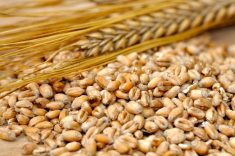Glacier FarmMedia | MarketsFarm — Proposed tariffs from United States President Donald Trump on Canadian and Mexican imports could cause major changes to Western Canadian feedlots.
Jim Beusekom, president of Market Place Commodities in Lethbridge, Alta., said buyers south of the border will be more inclined to purchase cattle being fed rather than finished animals, which could potentially send more head into the U.S.
Feed grain imports likely hindered
He also fears that Canada’s planned retaliatory tariffs will hinder feed grain imports from the U.S., as well as hurt grain farmers in Western Canada.
Read Also

Ample supplies and improved livestock sector to boost Canadian feed sector: FCC
Abundant feed grain supplies and improved profitability for the livestock sector should support strong feed demand and sales through the winter, says a new report from Farm Credit Canada.
“Corn and barley are the big ones. If (imports) are shut down across Canada, it could raise our feed prices here. That would further encourage feedlots to move our cattle into the U.S. to finish. It’s a double-edged sword, if you would call it that,” Beusekom said.
“It would be best if Canada would mind their own manners and not countervail feed grains, which is not going to help the cattle feed industry.”
Grain deliveries slow
Feed grain deliveries in Lethbridge have been “slow to steady”, Beusekom added, citing the ongoing decline in cattle numbers. At the moment, feed barley was selling at C$300 per tonne, with feed wheat at C$310/tonne and corn at C$315 to C$320/tonne.
“It’s more advantageous for livestock feeders to supply barley or wheat. They don’t need to buy anymore, so we’re not seeing a lot of action. It’s been on the quiet side,” he said, adding that corn demand only picks up if barley supplies are tight.
“As of right now, we still have plenty of barley around. There’s really no demand until we get into late spring or summer when barley will tighten up.”

















